Abstract
AIMS/BACKGROUND--This study was initiated to investigate risk factors for and outcome of Acanthamoeba keratitis. METHODS--Results of treatment were studied in 22 patients (23 eyes) presenting to Bristol Eye Hospital between 1985 and February 1995. Details related to the use and disinfection of contact lenses were also obtained. An additional two patients who were seen at Bristol but mainly treated elsewhere were surveyed for contact lens related information only. RESULTS--The incidence of Acanthamoeba keratitis rose substantially in the 1990s: three patients presented before 1990, while the remaining 21 presented between January 1990 and February 1995. Eleven patients have presented since january 1994. All of the patients in this series were contact lens wearers, 16 (67%) using daily wear disposable contact lenses. Contact lens disinfection data were available in 22 patients of whom 11 (50%) were using chlorine disinfectant. Other types of disinfection were much less common. Four patients (18%) had not used any disinfectant. During the course of the series the average diagnostic delay has fallen markedly, although in 77% of patients a diagnosis of a viral keratitis, most commonly herpes simplex, was made on first presentation. All but three of the series were treated with a combination of polyhexamethylene biguanide and propamidine isethionate. Penetrating keratoplasty was performed in 9/23 eyes (39%); in all of these eyes diagnosis was delayed for at least 6 weeks. All but one of the eyes in the series achieved a visual acuity of 6/9 or better after treatment, and 18 eyes (78%) saw 6/6 or better. CONCLUSIONS--Most patients with Acanthamoeba keratitis can now expect a good visual result and cure by medical therapy alone is favoured by early diagnosis.
Full text
PDF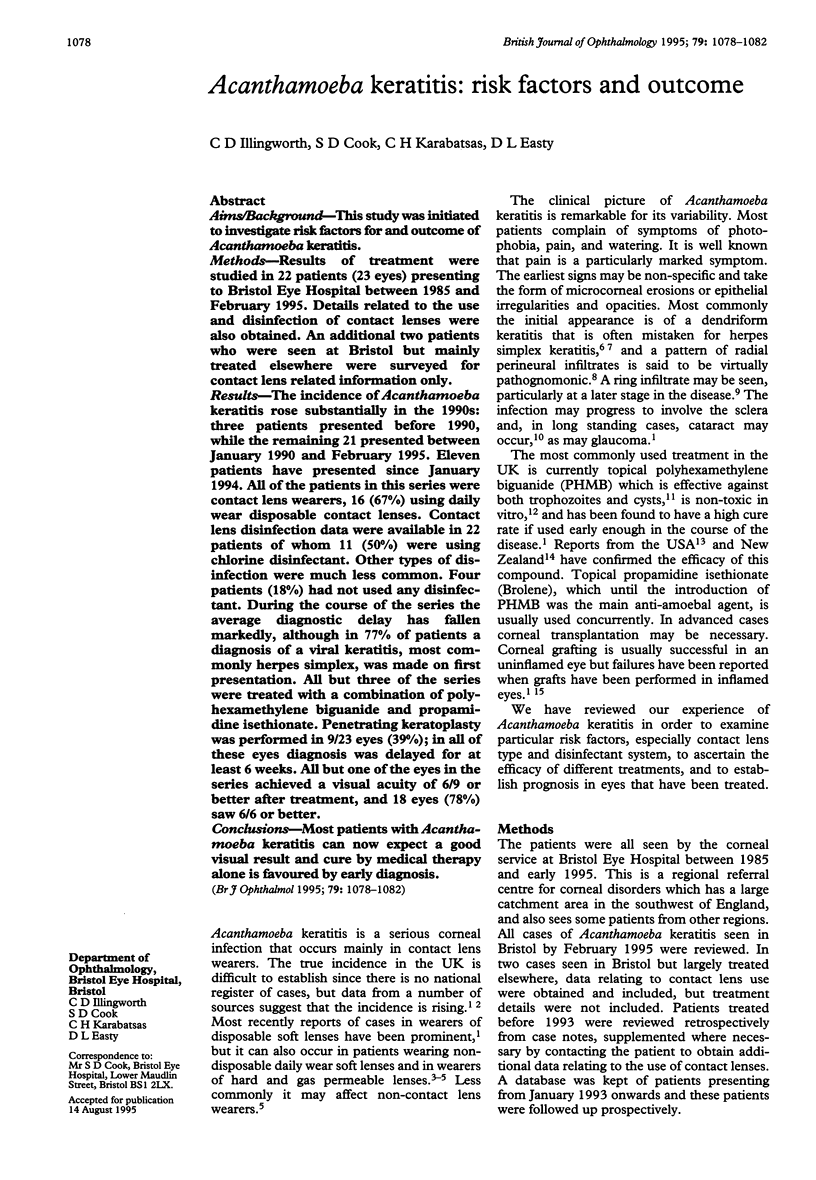
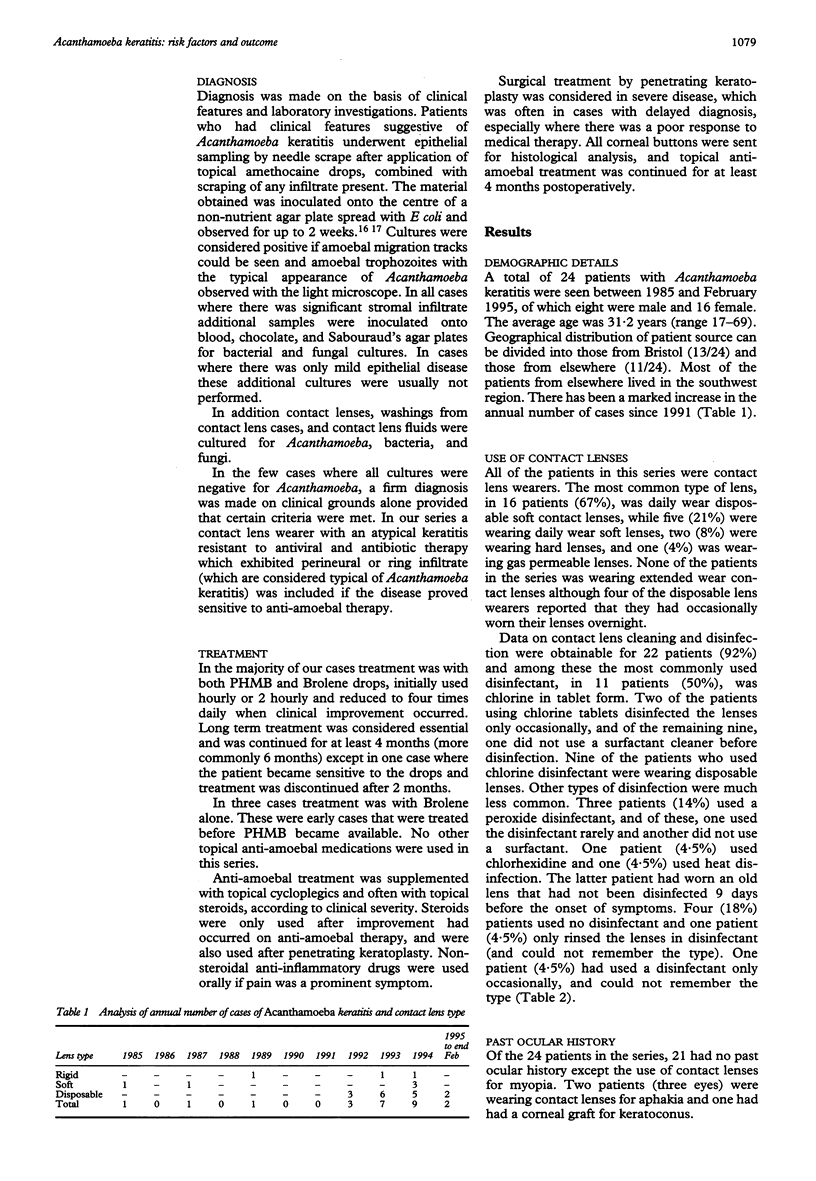
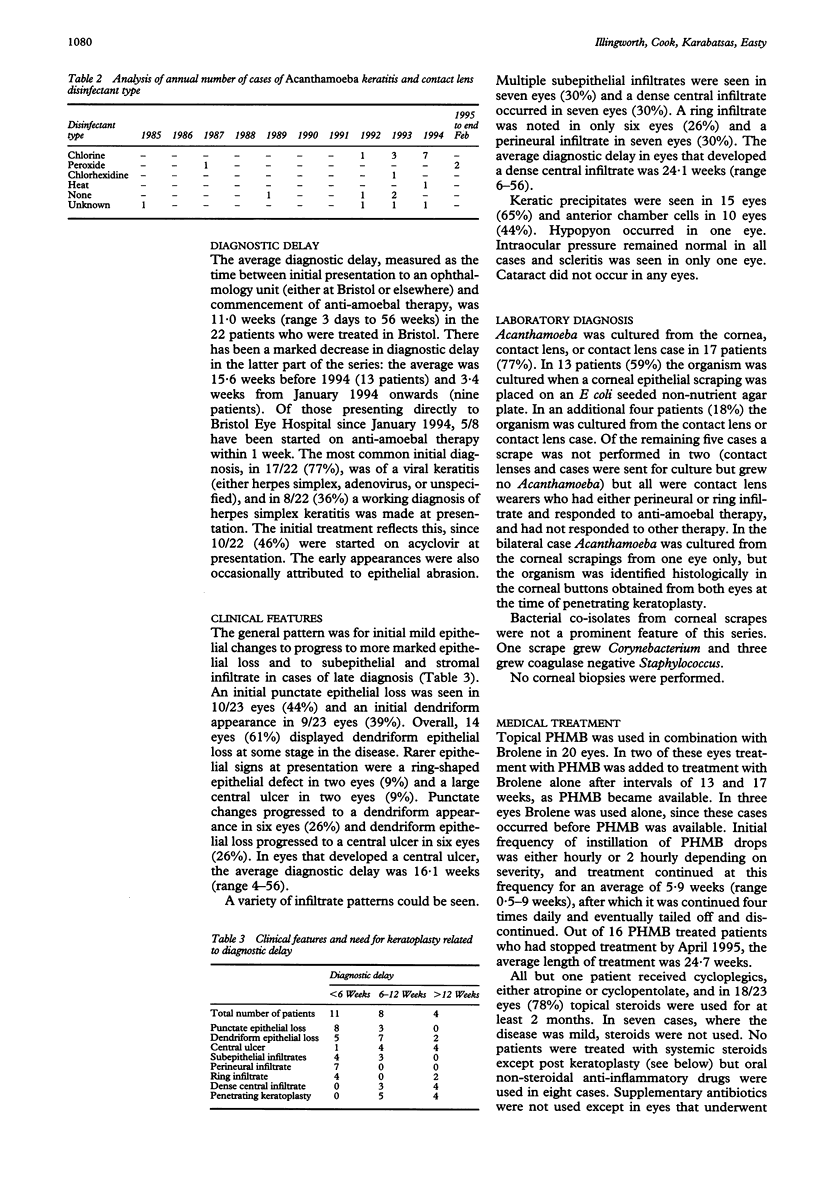
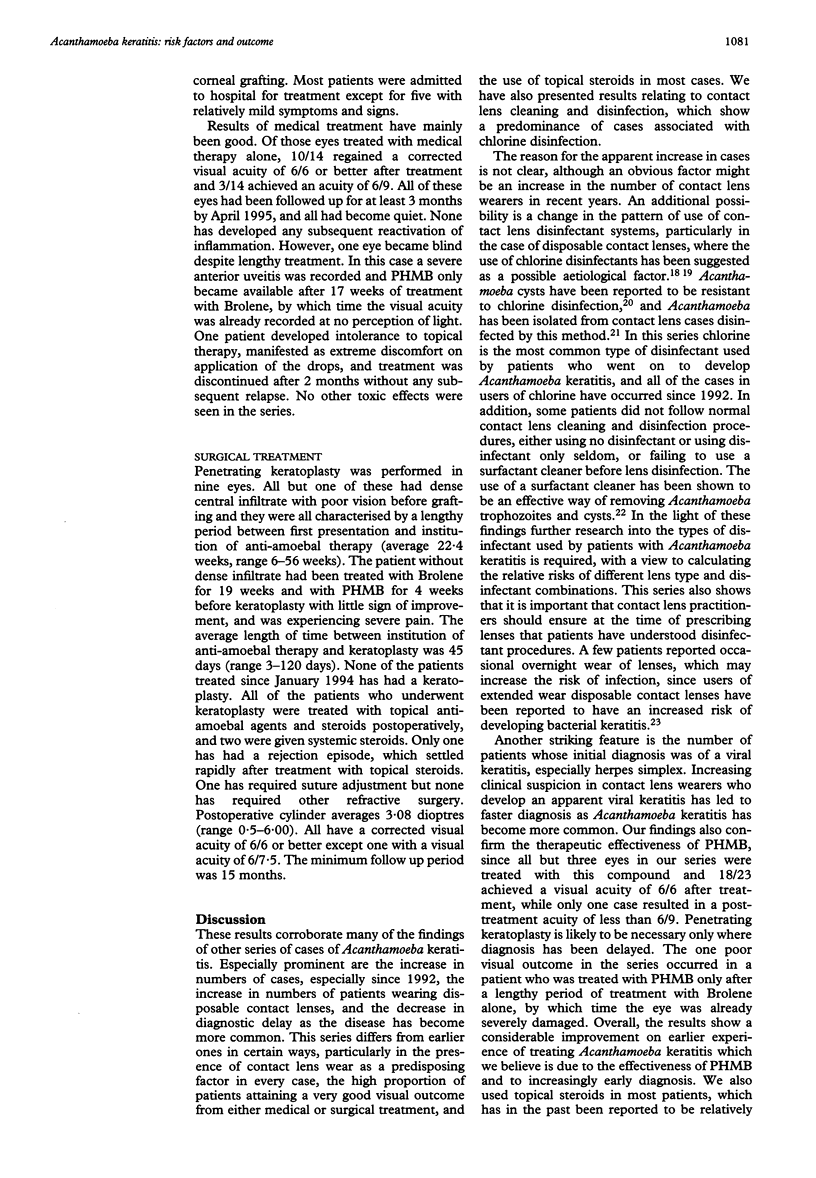
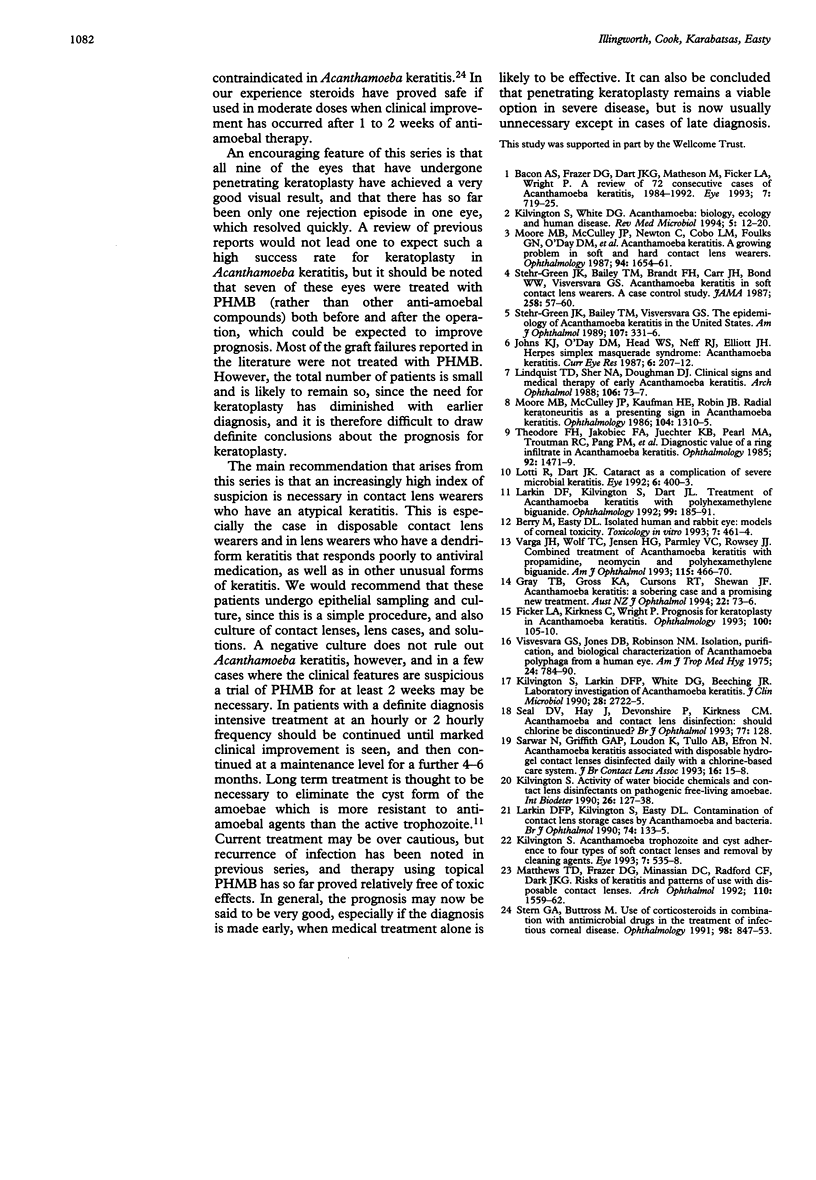
Selected References
These references are in PubMed. This may not be the complete list of references from this article.
- Bacon A. S., Frazer D. G., Dart J. K., Matheson M., Ficker L. A., Wright P. A review of 72 consecutive cases of Acanthamoeba keratitis, 1984-1992. Eye (Lond) 1993;7(Pt 6):719–725. doi: 10.1038/eye.1993.168. [DOI] [PubMed] [Google Scholar]
- Ficker L. A., Kirkness C., Wright P. Prognosis for keratoplasty in Acanthamoeba keratitis. Ophthalmology. 1993 Jan;100(1):105–110. doi: 10.1016/s0161-6420(93)31707-0. [DOI] [PubMed] [Google Scholar]
- Gray T. B., Gross K. A., Cursons R. T., Shewan J. F. Acanthamoeba keratitis: a sobering case and a promising new treatment. Aust N Z J Ophthalmol. 1994 Feb;22(1):73–76. doi: 10.1111/j.1442-9071.1994.tb01700.x. [DOI] [PubMed] [Google Scholar]
- Johns K. J., O'Day D. M., Head W. S., Neff R. J., Elliott J. H. Herpes simplex masquerade syndrome: acanthamoeba keratitis. Curr Eye Res. 1987 Jan;6(1):207–212. doi: 10.3109/02713688709020092. [DOI] [PubMed] [Google Scholar]
- Kilvington S. Acanthamoeba trophozoite and cyst adherence to four types of soft contact lens and removal by cleaning agents. Eye (Lond) 1993;7(Pt 4):535–538. doi: 10.1038/eye.1993.116. [DOI] [PubMed] [Google Scholar]
- Kilvington S., Larkin D. F., White D. G., Beeching J. R. Laboratory investigation of Acanthamoeba keratitis. J Clin Microbiol. 1990 Dec;28(12):2722–2725. doi: 10.1128/jcm.28.12.2722-2725.1990. [DOI] [PMC free article] [PubMed] [Google Scholar]
- Larkin D. F., Kilvington S., Dart J. K. Treatment of Acanthamoeba keratitis with polyhexamethylene biguanide. Ophthalmology. 1992 Feb;99(2):185–191. doi: 10.1016/s0161-6420(92)31994-3. [DOI] [PubMed] [Google Scholar]
- Larkin D. F., Kilvington S., Easty D. L. Contamination of contact lens storage cases by Acanthamoeba and bacteria. Br J Ophthalmol. 1990 Mar;74(3):133–135. doi: 10.1136/bjo.74.3.133. [DOI] [PMC free article] [PubMed] [Google Scholar]
- Lindquist T. D., Sher N. A., Doughman D. J. Clinical signs and medical therapy of early Acanthamoeba keratitis. Arch Ophthalmol. 1988 Jan;106(1):73–77. doi: 10.1001/archopht.1988.01060130079033. [DOI] [PubMed] [Google Scholar]
- Lotti R., Dart J. K. Cataract as a complication of severe microbial keratitis. Eye (Lond) 1992;6(Pt 4):400–403. doi: 10.1038/eye.1992.82. [DOI] [PubMed] [Google Scholar]
- Matthews T. D., Frazer D. G., Minassian D. C., Radford C. F., Dart J. K. Risks of keratitis and patterns of use with disposable contact lenses. Arch Ophthalmol. 1992 Nov;110(11):1559–1562. doi: 10.1001/archopht.1992.01080230059020. [DOI] [PubMed] [Google Scholar]
- Moore M. B., McCulley J. P., Kaufman H. E., Robin J. B. Radial keratoneuritis as a presenting sign in Acanthamoeba keratitis. Ophthalmology. 1986 Oct;93(10):1310–1315. doi: 10.1016/s0161-6420(86)33572-3. [DOI] [PubMed] [Google Scholar]
- Moore M. B., McCulley J. P., Newton C., Cobo L. M., Foulks G. N., O'Day D. M., Johns K. J., Driebe W. T., Wilson L. A., Epstein R. J. Acanthamoeba keratitis. A growing problem in soft and hard contact lens wearers. Ophthalmology. 1987 Dec;94(12):1654–1661. [PubMed] [Google Scholar]
- Seal D. V., Hay J., Devonshire P., Kirkness C. M. Acanthamoeba and contact lens disinfection: should chlorine be discontinued? Br J Ophthalmol. 1993 Feb;77(2):128–128. doi: 10.1136/bjo.77.2.128. [DOI] [PMC free article] [PubMed] [Google Scholar]
- Stehr-Green J. K., Bailey T. M., Brandt F. H., Carr J. H., Bond W. W., Visvesvara G. S. Acanthamoeba keratitis in soft contact lens wearers. A case-control study. JAMA. 1987 Jul 3;258(1):57–60. [PubMed] [Google Scholar]
- Stehr-Green J. K., Bailey T. M., Visvesvara G. S. The epidemiology of Acanthamoeba keratitis in the United States. Am J Ophthalmol. 1989 Apr 15;107(4):331–336. doi: 10.1016/0002-9394(89)90654-5. [DOI] [PubMed] [Google Scholar]
- Stern G. A., Buttross M. Use of corticosteroids in combination with antimicrobial drugs in the treatment of infectious corneal disease. Ophthalmology. 1991 Jun;98(6):847–853. doi: 10.1016/s0161-6420(91)32211-5. [DOI] [PubMed] [Google Scholar]
- Theodore F. H., Jakobiec F. A., Juechter K. B., Ma P., Troutman R. C., Pang P. M., Iwamoto T. The diagnostic value of a ring infiltrate in acanthamoebic keratitis. Ophthalmology. 1985 Nov;92(11):1471–1479. doi: 10.1016/s0161-6420(85)33830-7. [DOI] [PubMed] [Google Scholar]
- Varga J. H., Wolf T. C., Jensen H. G., Parmley V. C., Rowsey J. J. Combined treatment of Acanthamoeba keratitis with propamidine, neomycin, and polyhexamethylene biguanide. Am J Ophthalmol. 1993 Apr 15;115(4):466–470. doi: 10.1016/s0002-9394(14)74448-4. [DOI] [PubMed] [Google Scholar]
- Visvesvara G. S., Jones D. B., Robinson N. M. Isolation, identification, and biological characterization of Acanthamoeba polyphaga from a human eye. Am J Trop Med Hyg. 1975 Sep;24(5):784–790. doi: 10.4269/ajtmh.1975.24.784. [DOI] [PubMed] [Google Scholar]


